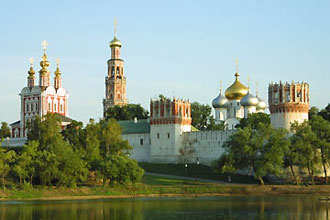See all Attractions in Moscow
Novodevichy Convent
Novodevicij pr-d, 1, Moscow, Russia, 119435 Phone: 74992468526 http://www.moscow.info/orthodox-moscow/novodevichy-convent.aspxAbout
Founded in 1524 by Grand Duke Vasily III to celebrate the recapture of Smolensk from the Lithuanians, the Novodevichy Convent is one of the most beautiful sights in Moscow. It is particularly notable for its architectural harmony of which its position, on the banks of the Moskva River, allows excellent views. The convent is also famous for its New Cemetery, which became the most prestigious in the city in the last century and the final resting place for a number of great cultural and political figures, including Chekhov and Shostakovich. The postcard loveliness belies the Convent's original function as one of the ring of fortresses that guarded the outskirts of the medieval city. Novedichy was positioned strategically to protect the main southern access road to the city at the point where it crossed the Moskva. The convent has enjoyed a prominent place throughout its history, in part as a repository for powerful and troublesome women, most famously the Regent Sophia, Peter the Great's half-sister, who did much to rebuild the convent in the 1680's before being confined here after the streltsy revolted in support of her in 1698. During Napoleon's invasion, the monastery weathered French efforts to blow it to pieces, thanks to some quick-thinking nuns who managed to extinguish the fuses on casks of gunpowder after the soldiers had fled. The convent also made notable appearances in 19th Century fiction, as the site of Pierre's proposed execution in War and Peace, and as the meeting place for Lyovin and Kitty in Anna Karenina (the Maiden Field, below the convent walls, was Moscow's most fashionable skating rink, frequented by Tolstoy). After the Revolution, the Convent was turned into the Museum of the Emancipation of Women, but suffered less than many of its counterparts, and was one of the first to be returned to the Church in the patriotic fervor that followed victory in 1945. Nuns did not return here until 1994, however, and it is still much more of a tourist attraction than a working religious institution - for which we can only be grateful considering the wealth of treasures to be seen. The Cathedral of Our Lady of Smolensk is the oldest, and the most important, building in the convent. It was built at the time of the Convent's founding, although its dazzling onion domes were added over a century later. The interior is also impressive, with glorious frescoes dating from 1684 and painted by Dmitry Grigorev of Yaroslavl. There is also a fine five-tiered iconostasis dating from the same period, but in fact brought from the Assumption Church in Pokrovka, which was destroyed by the Bolsheviks. Most of the other buildings of note date from Regent Sophia's time, including the red and white Church of the Assumption and the neighboring refectory, the soaring bell-tower and the north and south gate churches, all of which display variations of the same Moscow Baroque style, making the Convent one of the most resplendent examples of the period. The cemetery next-door is well worth visiting also, not just to pay homage to the great and good buried here - Chekhov, Bulgakov, Prokofiev, Shostakovich, Eisenstein and Stanislavsky, to name but a few - but also to marvel at the extraordinary granite and metal monstrosities that crown the graves of various politicians and military commanders of the Soviet era. It is a fascinating experience.
